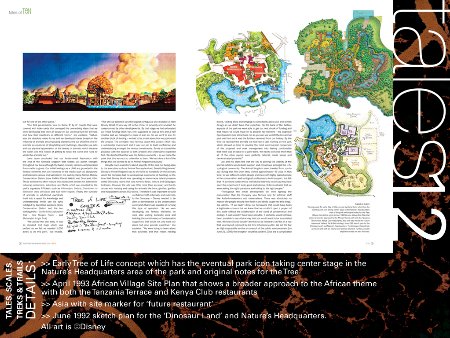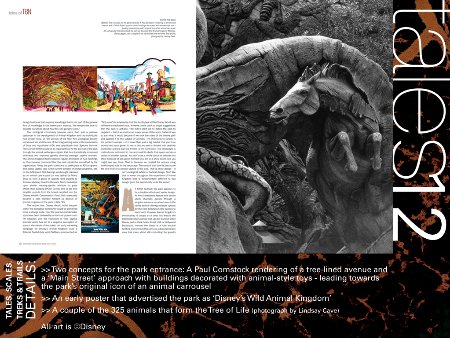Disney's Animal Kingdom at Ten
Page 2 of 5
�Throughout the initial development we were fighting the presumption that the Company was famous only for artificial stuff like Audio-Animatronics and make-believe. There was absolutely no reason why people should have faith in our ability to get into this thing,� Joe admits. �If we hadn�t done our homework that would have been a legitimate concern but we knew that we couldn�t open a project of this scale without the collaboration of the world of conservation and zoology. It just wouldn�t have been possible. It certainly would not have been possible in any ethical way that you would want to be associated with. We knew Disney couldn�t be that so we needed to do this in a way that was beyond reproach by the time it became public. We set the bar as high as possible so that as a result of the public announcement [on June 21, 1995] the reception would be positive. Zoos are a complicated design business that requires knowledge that is not part of the general font of knowledge in the theme park industry. We needed the time to educate ourselves about how this was going to work.�

Click here for a much larger version of this picture
An early marketing campaign for Disney�s Animal Kingdom used a fictional Swahili-type word Nahtazu (pronounced as �Not a zoo�) to emphasize that the fourth park at Walt Disney World was different to traditional zoos. However Joe is quick to dispel suggestions that the park is anti-zoo: �We didn�t start out to define the park by negation � that it was not a zoo in any sense of the word. Rather it was to say what it would become if we took the rules of the theme park and applied it to the subject of animals. The [Kilimanjaro] Safaris is the perfect example � it is more than just a big habitat that you drive around and spot game. It has a plot arc and is divided into carefully controlled scenes just like Pirates of the Caribbean. The landscape is meticulously cultivated to rise and swell to divide that space up into a series of smaller spaces. You don�t see a whole bunch of vehicles out there because at any given moment you are in a show scene and you might see say, three. That is because we created the scenes using bowl-shaped rolls in the landscape. The crest of that bowl is just above the eye level of a person seated in the jeep. That is show design � it isn�t zoological exhibit or habitat design. Stuff like that is woven throughout the experience of Animal Kingdom that is fundamentally different to zoo design given the opportunity to do the same.�

Click here for a much larger version of this picture
Animal Kingdom�s entranceway is unique as it does not feature the traditional retail avenue that can be found at other Disney parks (think Main Street USA or Hollywood Boulevard). Instead the Oasis is a lush tropical twisting environment that acts as a decompression zone that rises whilst still controlling the guest�s view until the bridge to Discovery Island. However the concept moved through multiple gyrations prior to the final design. �We went around and around on the entrance sequence,� Joe admits. �We really wanted something radical. One concept was to set up the story of an abandoned zoo � guests would have walked past all of these cages and stalls open. Another idea was for a children�s toy box of stuffed animals. We went through so many different notions as we felt that for people to understand that this park is different the entry sequence needed to be that different.�
�Eventually we just took everything out of it and left it all about the animals. We built the pathway all curvy to encourage you to explore but also to control the view until we were ready to reveal Safari Village on Discovery Island. It sets up the expectation,� Joe continues. �We could have done the Oasis without any animals which would have served the same narrative goal to reinforce that this is not your typical theme park. It is not a town, street, monument or pavilion. You have to find your own way through it � it is not explicitly clear where you should be going and there are multiple options. It also conditions guests that they are going to have to look to find the animals � they aren�t popping out just for you. Hopefully that helps calm people down � you aren�t rushing to the first attraction of the day. Also as the walkway is on an incline it should make you slow down. This is not a park where you profit by pinging off E-Tickets and running from place to place. This really is Shangri-la. Also when you pop out of the Oasis you are at a considerable height � your feet are higher than the heads on Discovery Island. You then drop into this valley. We tried really hard � perhaps too hard at times � to create this sense of adventure. All of the paths are curvilinear. We had deliberately tried to push the envelope away from the usual theme park model towards one that expresses animals, nature and adventure.�
